CASE 4A: Treatment of high traffic roads and residential areas in the Antwerp region
Partner in charge: Aquafin
Location: Berchem, Flanders (BE)
A full-scale demonstration site at park Brialmont and Wolvenberg is being developed because of the ambition of the city of Antwerp to become a climate robust city taking up the challenge of flooding by relieving the sewer system and so being prepared for the future. Wolvenberg, since its recognition in 2001, is the only nature reserve in the city of Antwerp. The park is located close to the train station of Berchem, a district in the southern part of the city and based on top of the remains of the surrounding walls of Antwerp. The site has been set up as a nature walking park and a playground open to the general public.
Current Status Case Study + Needs for Improvement:
At the demo site, runoff water from old Berchem (a nearby residential area occasionally suffering from floods) and the Single (ring road around Antwerp) will be collected, buffered and infiltrated in swales. The swales are used as play areas in the park, so pollution has to be avoided on the surface and prevented from building up in the soil. Therefore, a nature-based filter system, i.e. a filter bed with gravel/drainage sand, will be installed to treat the water before it reaches the swales. Thus, the site allows for the evaluation/monitoring of pollution pathways from two different urban areas and the impact of a nature-based treatment technology on runoff quality.
Activities - Technical configurations and envisaged improvements
An inline smart monitoring system, including simple, robust online measurements and advanced automatic samplers will be implemented. This will enable monitoring pathways of pollutants of urban runoff, monitoring the full-scale nature-based filter system and modelling of the system performance. The monitoring setup for this site is shown in
the figure. Ten IoT sensor platforms will be installed on this site to continuously monitor incoming flow at the ten inlets. This is the starting point for using IoT to trigger the in-situ sampling. The IoT sensor platform can monitor easy-to-monitor parameters and steer in-situ sampling at critical times. Each of these inline IoT sensor platforms will continuously measure the following parameters: Electrical conductivity, Turbidity with both sensors being connected to the datalogger, Water level. 5 sampling devices will be coupled to an IoT sensor platform and will be used for the in-situ sampling.
Ambition until the Project End and Beyond
Within the pilot site, a prototype of a smart inline monitoring system will be developed and implemented. Monitoring effectiveness of a full-scale nature-based filter system will be achieved. Recommendations will be produced for the application of nature-based filter system as pre-treatment for water infiltration.
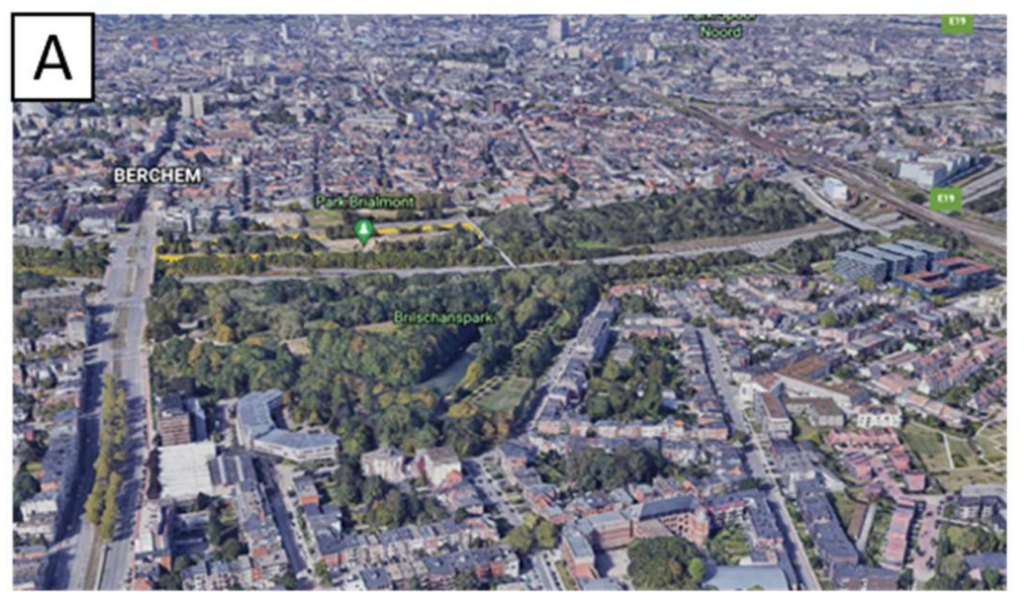
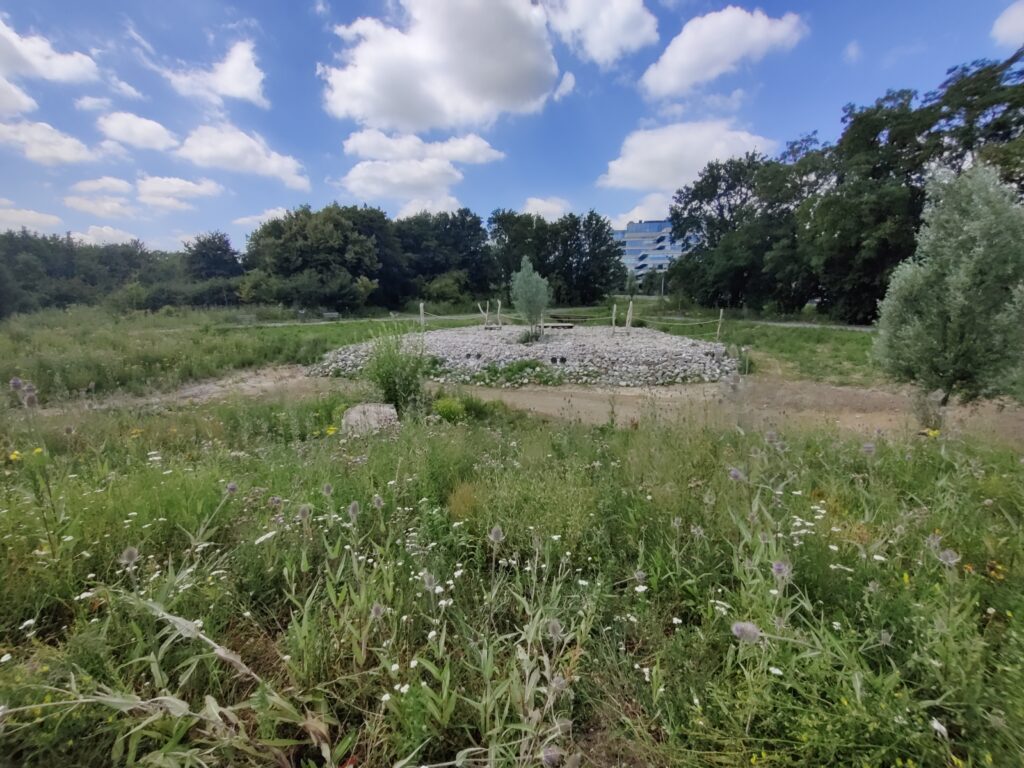
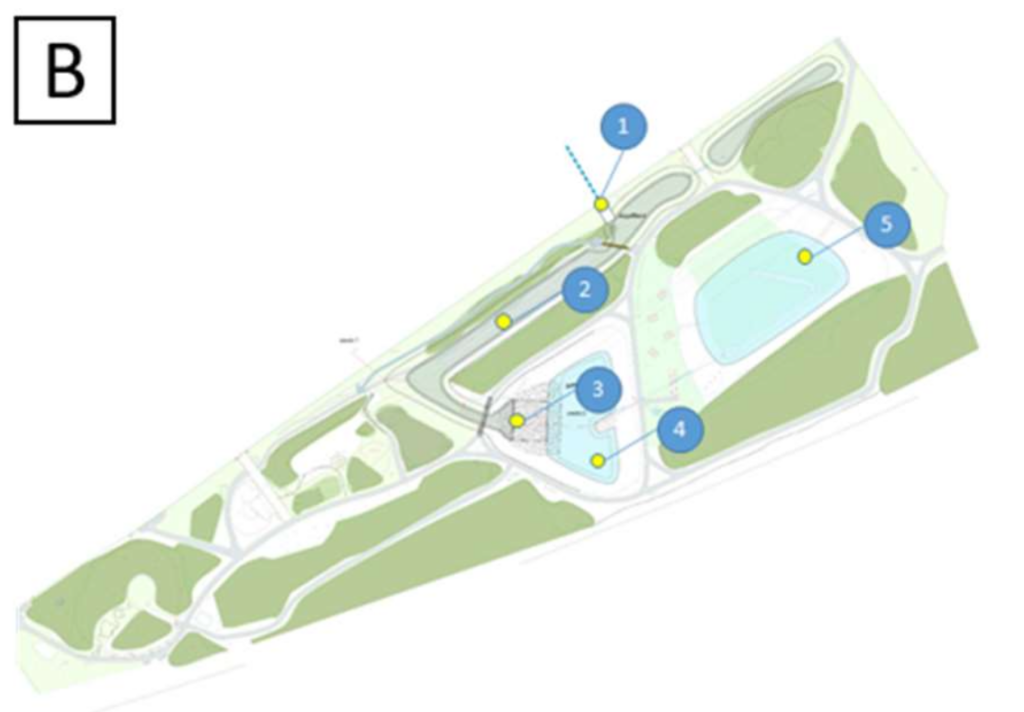
(A) Aerial view in Google Earth of the Wolvenberg site (yellow frame at the park Brialmont); (B) A detailed overview of the Wolvenberg site. 1) the inlet of the collected urban runoff water from both the ring road the Single and the residential area from old Berchem, 2) buffer system, 3) the filter, 4) the small swale and 5) the large swale.
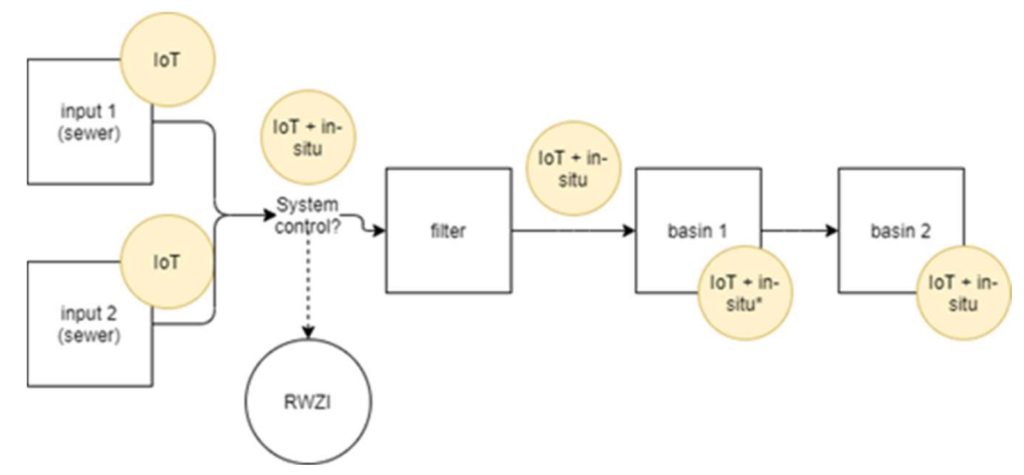
CASE 4B: Shopping area runoff characterization and treatment
Location: Wetteren, Flanders - Belgium
A shopping area in Wetteren has surface water runoff from the shop roofs and the parking lots, amounting to an area of 3500 m2. This is partly collected in an Urban Rainshell (URS) and purified for reuse as play water and for irrigation of communal gardens. The blue surface (see figure) indicates the surface where water is collected and passed to the URS and the swale. The treatment capacity of the URS is tailored for a relatively low flow rate (approx. 5000m3 runoff water), given the type of water use. When the URS is full, the water goes untreated via a swale to be discharged in the rainwater drainage system. The URS does have an overflow to the swale, closed with a manual valve that can be opened for research purposes.
Current Status Case Study + Needs for Improvement:
The collection system for the runoff water and the URS system were installed in the spring of 2021. The system is in operation and is monitored based on grab samples since construction. As part of the Dutch research project TKI Circular Rain, the system is being monitored for its first year. Through StopUP, the long-term performance of the system will be evaluated. This will be done by using the overflow valve and adjusting the load of stormwater passing through the URS. This provides the opportunity to study the lifetime of the URS. During the project, the need for a pre-treatment (sand trap or mechanical screens) will be evaluated (to ensure the hydraulic functioning) and a more detailed monitoring campaign will shed light on system dynamics. Furthermore, soil and groundwater pollution will be measured in a swale next to the filter that captures the non-purified stormwater. Finally, the impact of emerging contaminants such as PFAS and micro-plastics will be added to the monitoring.
Activities - Technical configurations and envisaged improvements
Monitoring pathways of pollutants of urban runofff, Monitoring the full-scale nature-based filter system, Adaptation of system to increase lifetime treatment capacity, Modelling of the long-term system performance
Ambition until the Project End and Beyond
Demonstrate long term effectiveness of a full-scale URS-system as pre-treatment for water infiltration
Derive recommendations for a full-scale URS-system as pre-treatment for water infiltration
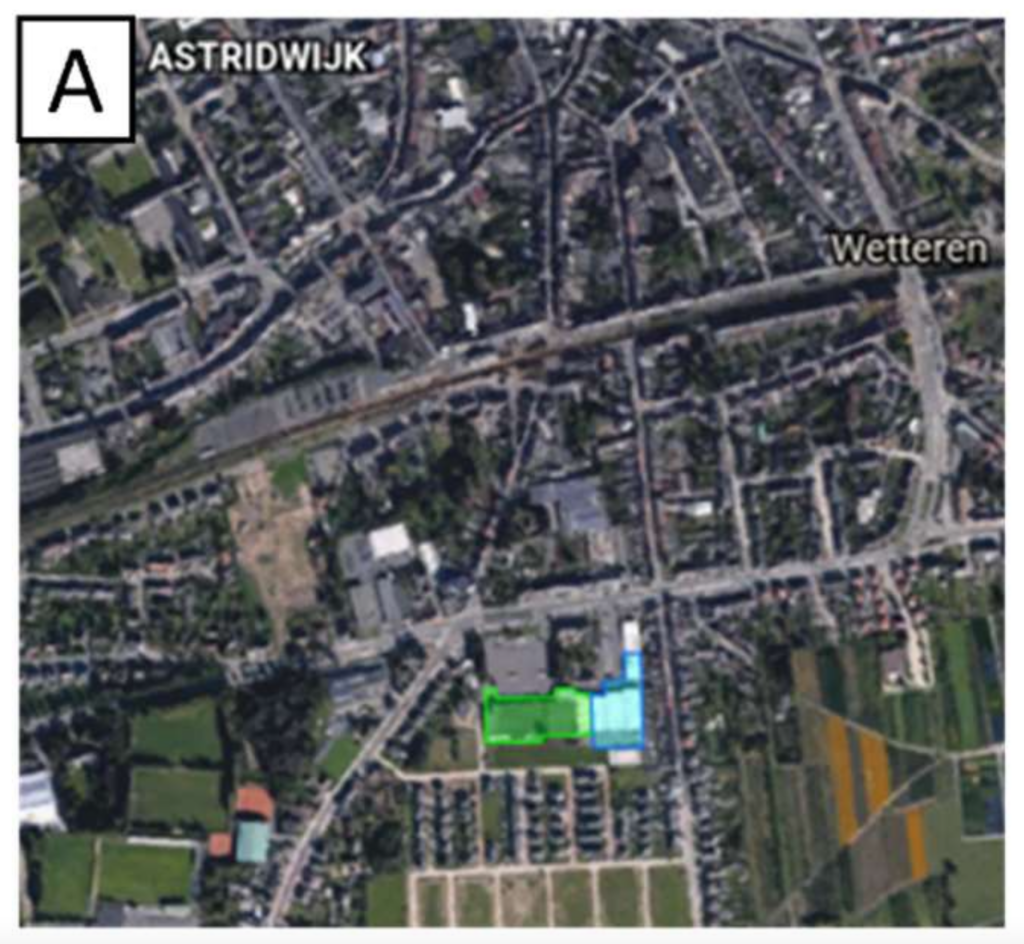
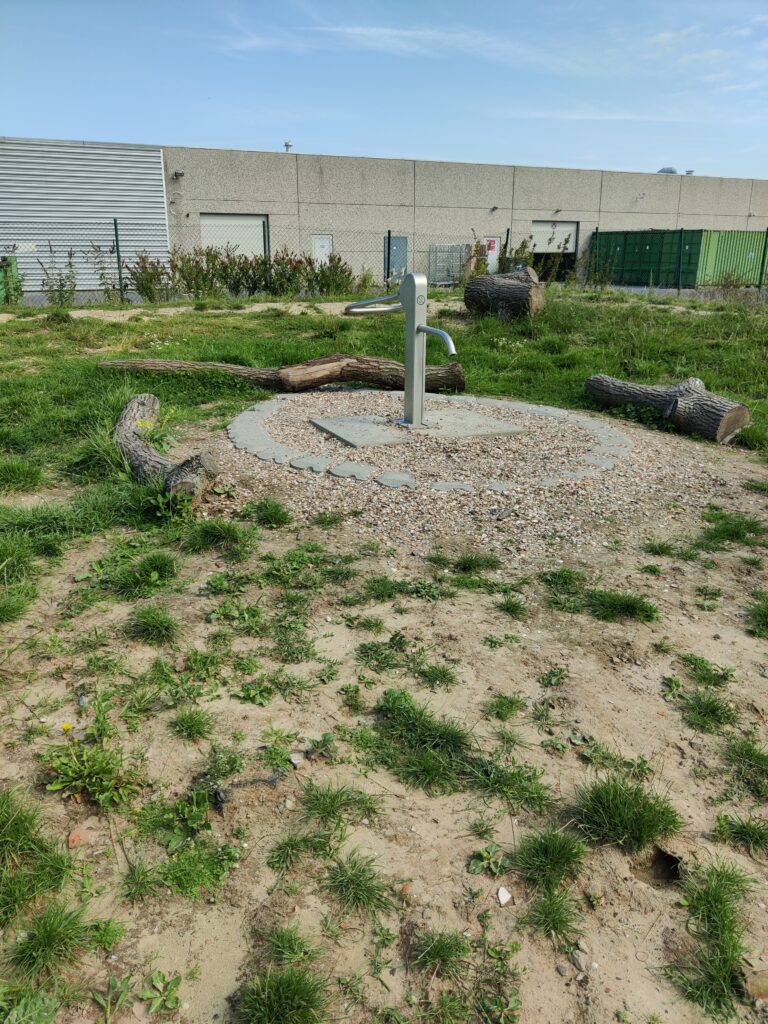
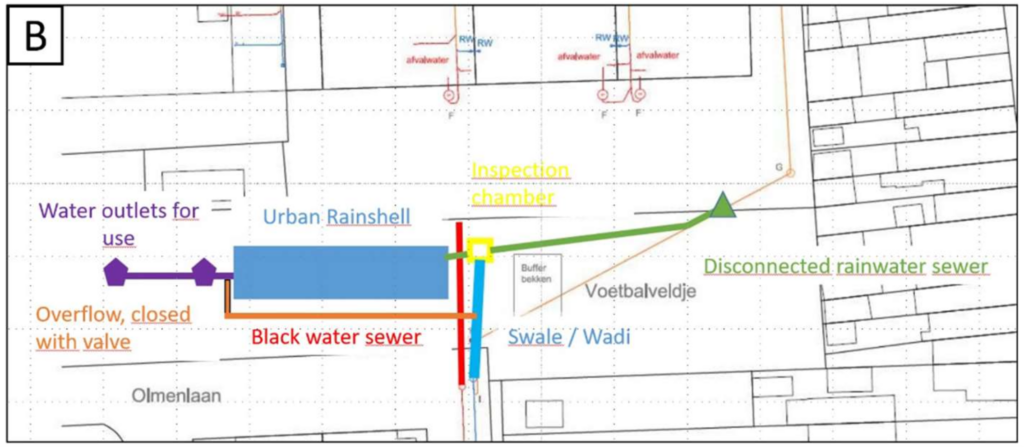
(A) Location of the shopping area in Wetteren (Flanders, Belgium) on Google maps (B) Schematic overview of Wetteren pilot.
